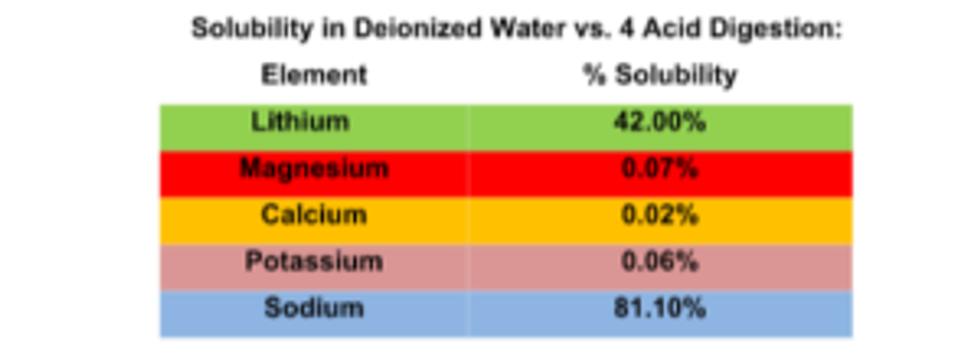Cypress Begins Drill Program at Dean Lithium Claystone Project in Clayton Valley, Nevada, Completes Water Solubility Study

https://investingnews.com/company-profiles/cypress-development-lithium-stocks-clayton-valley/
Cypress Development Corp.(TSXV:CYP) is pleased to announce it has commenced mobilization of a drilling program to explore for depth extensions of outcropping lithium mineralization in uplifted basin evaporite bearing mudstone and claystone at its 2,700 acre “Dean” Project located in the central Clayton Valley of Nevada.
Cypress Clayton Valley Lithium Project, Nevada location map:
https://www.cypressdevelopmentcorp.com/i/maps/CYP-Clayton- topo-satalite- small.jpg
The Company’s Dean Project is located to the immediate east of lithium brine wells belonging to the
Albemarle Silver Peak Mine with Cypress’; Glory Project located to the immediate south and Advantage
Lithium’s/Nevada Sunrise’s project located to the immediate north.
Extensive sampling by Cypress at the Dean Project has identified strong lithium mineralization up to 3,700 ppm lithium (1.98% lithium carbonate equivalent) in a highly soluble uplifted lakebed mudstone and claystone in the 2 square kilometer Frontera Verde Zone that averages 1,500 ppm lithium (0.80% lithium carbonate equivalent) at surface.
Outcropping lithium-rich mudstones at Dean Project:
https://www.cypressdevelopmentcorp.com/i/photos/DEAN-CYP_Clayton_Valley_Lithium_Mineralized_Claystone.jpg
The U.S. Bureau of Land Management has approved 12 exploration drill hole locations into the Dean Frontera Verde Zone. Cypress plans to drill the 12 vertical holes using NQ diamond drill core methods of approximately 2 inch diameter core. Morningstar Drilling of Three Forks, Montana will complete the drilling. Drilling is expected to begin on or about February 15, 2017.
In addition to planning and starting the Dean drill program, Cypress has been closely analyzing the chemistry of the known mineralized rocks by conducting a detailed study comparing Cypress’ original assays (total extraction four-acid assays) to the 2 results of selective leach extraction deionized water assays. Deionized water is water of neutral pH and is basically identical to rain water or distilled water.
The finding of the study can be summarized as extremely encouraging for the planning of future more advanced lithium extraction investigations. The results of this latest study are presented below.
Analysis of Deionized Water Leach Assay Results from Dean Lithium Project
Summary:
A total of fifty surface samples from the Dean property have been analyzed by ALS Chemex’s lab in Reno, Nevada using method ME-MS03. This method involves using deionized water as the leach agent for extraction of easily soluble minerals and other element ions that are present in the prepared rock sample pulps.
The purpose of this work was an initial evaluation of extraction of lithium and other elements from the samples using water only. The important questions to answer in this study were the solubility of lithium in water and also the solubility of other associated evaporite elements such as sodium, potassium, magnesium and calcium.
Data, Methodology and Results:
The core data for this study were assay results from two fundamentally different assay procedures. The methods are;
1. ME-ICP61 method known as a four acid assay as it uses a mixture of acids to completely dissolve the sample in a highly corrosive solution of acids. The resulting solution is then analyzed for the amounts of individual elements present, here expressed as percent (%). This assay method produces complete accounting of the make-up of the rock being assayed, nothing is left behind. This is known as complete digestion.
2. ME-MS03 method which uses only deionized water as the leaching solution. Assay results from this method will be entirely dependent of the solubility, in water, of the minerals or ion complexes that occur in the sample. This method will not extract elements from many minerals including silicates, sulfides, carbonates etc.
The results of this study are formed by comparing the assays from these two very different methods for the elements of importance in the Clayton Valley; lithium (Li), magnesium (Mg), calcium (Ca), potassium (K) and sodium (Na).
An ideal outcome of a water leach assay would be a large percentage extraction of lithium along with a low percentage extraction of other evaporite elements, especially magnesium and calcium, versus the assays of these elements in the four acid method.
The results of the fifty deionized water leach assays show exactly that, strong extraction of lithium with very low extraction of magnesium and calcium. The water and soluble element “synthetic brine” produced for assay from the samples has very 3 similar chemistry to that of reported chemistry of production brines from the Clayton Valley and to brines reported by Pure Energy Minerals within their northern resource area.
This similarity of the “synthetic brine” from the Cypress deionized water leach assay (ALS Chemex method ME-MS03) compared to production and resource brines in the Clayton Valley is most clearly seen in the ratios of lithium vs. other evaporite elements in solution. These ratios are the standard reporting structure for the evaluation of the chemical quality of brines worldwide. In particular, relatively high amounts of lithium in comparison to the amount of magnesium and calcium in solution that are critical parameters in evaluating the suitability of a brine for processing using both traditional and new-era lithium production processes.
For Cypress, the comparison of the lithium to calcium, sodium, potassium and magnesium ratios for our deionized water leach brine, or synthetic brine, to the same ratios for both production brines and brines included in lithium resource estimates within the Clayton Valley is of critical importance in providing a first order estimation of the suitability of these synthetic brines for lithium extraction processing using either the traditional evaporation and precipitation process similar to Albemarle’s Silver Peak Mine or for possible processing in one of the new processes being developed by Pure Energy Minerals.
Cypress used public data that exists for a number of samples of these production and resource brines for this study. These data came from Pure Energy’s July 28, 2015 NI 43-101 Technical Report on its Clayton Valley South lithium project and from subsequent news releases by Pure Energy Minerals. The inclusion of chemical data on Albemarle’s production brines was possible by examining public data on these fbrines which are reported as part of Albemarle’s annual reporting requirements to the Nevada Department of Environmental Protection and to the State of Nevada Water Resources.
The key results of the Cypress solubility study are presented below beginning with a side by side comparison of assays (in percentage) of the important elements in the rock samples as reported by ALS Chemex for the two different assay methods. The pairs of numbers for each method represent the average for the fifty samples in the study:
Water Solubility of Lithium from Surface Rock Samples Comparison of Assays from Four Acid Digestion and Distilled Water Methods:
Lithium Magnesium Calcium Potassium Sodium
The results from the table above show that the deionized water leach assay method would result in a water solution containing an average of 0.05% Li, 0.14% Mg, 0.11% Ca, 0.29% K, and 2.9% Na. These results are compared to other basin brine chemistries below in this study. The values are straight assay values for the elements as found in the deionized water solution used in the assay procedure.
Read full company profile.
The study looked at the solubility of each of the important elements in a fashion which compares the complete extraction of each element in the four acid method versus the partial extract using only deionized water.
As the chart below clearly shows, two elements, lithium and sodium, show strong solubility into water versus a four acid solution while the remainder of the elements show remarkably low solubility in water versus a four acid solution. The difference is significant and the result is that a water solution is created which contains approximately 42% of the lithium and 81% of the sodium of the original rock but contains only trace amounts of the undesirable elements magnesium, calcium and potassium, all of which are less than 1%.
Solubility in Deionized Water vs. 4 Acid Digestion:
The table below compares the solution chemistry of the Dean deionized water “synthetic brine” produced by ALS Chemex during the ME-MS03 assays to actual production and resource brines in the Clayton Valley. Note that the lithium value for the water leach solution from Dean claystones is more than double that of the Pure Energy brine and is four times that of the Albemarle production brine.
Cypress Pure Energy Albemarle The data is significant when comparing the chemistry of the Cypress synthetic brine with two examples of brines from the Clayton Valley. As can be seen in the chart above, the Cypress synthetic brine is materially higher in lithium than the resource brine of Pure Energy Minerals or the production brine of Albemarle’s Silver Peak Mine.
The results needed to be viewed in relation to the other elements to more clearly see if these three different solutions containing lithium and other elements are truly similar. To do this, Cypress looked at ratios of lithium with the other elements in each sample. This produced the critical metal ratios which are used for the evaluation of the processing characteristics of brines in terms of efficiency of lithium extraction from the mineral brines.
The metal ratios for each of the three mineral brines are presented below:
Conclusions:
The ratio data above compares in an effective way the chemistries of a synthetic brine made from surface outcropping claystones on the Cypress Dean property with basin brines of the Clayton Valley. The ratios suggest that the synthetic brine is chemically very similar to the two selected basin brines. This is particular true in the critical magnesium/lithium (Mg/Li) ratio where the total range of values for the three solutions falls within a narrow range.
The following points are apparent and supported by the mineral solubility data:
1. It appears that a lithium bearing mineral solution that is chemically similar to the production and resource brines of the Clayton valley can be produced by the leaching of surface exposed evaporate stratigraphy in water.
2. Comparison of ratios with other important elements also shows the Dean “Synthetic Brine” to compare favorably with basin production brines.
3. The data provides further strong support for the idea that the production brines of the basin are being continuously recharged by leaching of lithium and other elements from the uplifted and exposed former lake basin sediments that outcrop in a wide belt along the east margin of the Clayton Valley.
4. This recharge mechanism strongly supports the importance of the outcropping and buried claystones as a very significant lithium source rock. Our chemistry work-up as presented here shows how rain water would extract lithium and sodium from the uplifted, mineralized basin sediments at much higher rates than the extraction of magnesium and calcium. This process would neatly account for the chemistry of basin production brines versus the chemistry of source rock claystones.
5. The potential for the existence of ground water mineral brines under and immediately adjacent to the exposed belt of lithium rich rocks is high as the water flow pathways for the recharge system are likely to be vertical as well as horizontal.
Don Huston, President of Cypress Development, stated: “Assays from surface sampling at the Dean Project have returned extremely encouraging results in the form of widespread high lithium mineralization hosted within highly reactive and soluble rock units. We have now completed detailed analysis of the results of several different assay methods as a first order study of potential extraction methods of the lithium from the host rock sequence. This study highlights the similarity of the solutions made from dissolving the surface claystone in water compared to production brines of the basin. The results of the study strongly indicate that recovery of lithium from a solution from the outcropping evaporates and water could potential be done by methods currently being used in the Clayton Valley and by new methods under development by Pure Energy Minerals and others.”
Robert Marvin, PGeo, Exploration Manager for Cypress Development Corp., is the qualified person as defined by National Instrument 43-101 and has approved of the technical information in this release.
About Cypress Development Corp.:
Cypress development Corp is a publicly traded lithium and zinc exploration company that continues to acquire and develop potentially viable mineral projects in the State of Nevada, U.S.A. Cypress is very active in Clayton Valley, Nevada with its team committed to systematically exploring its properties for both a lithium-brine resource and expanding exploration relating to the potential for a lithium resource that exists within the large area of non-hectorite “claystones” discovered at surface that has seen recent high lithium assays recovered from these same “claystones”. Cypress Development Corp. has approx. 33.4 million shares issued and outstanding.
Click here to connect with Cypress Development Corp.(TSXV:CYP) to receive an Investor Presentation.










